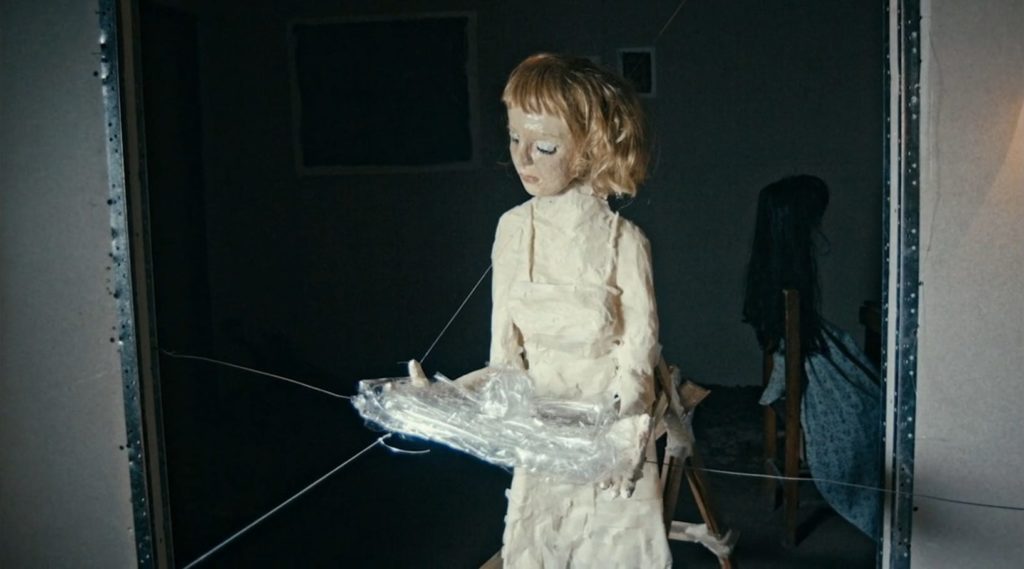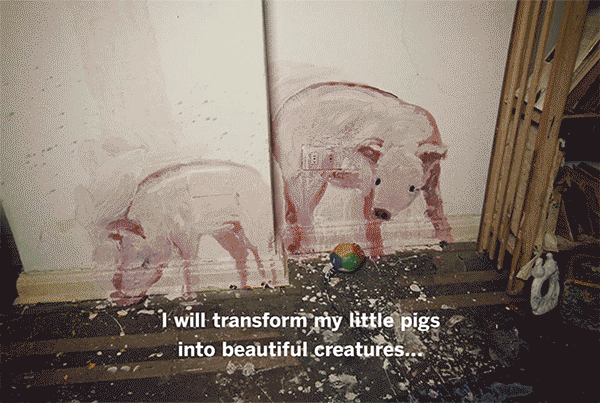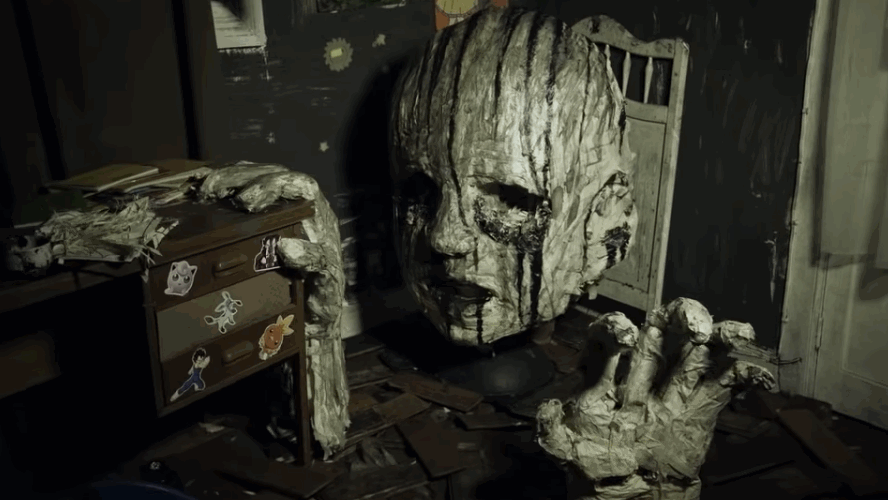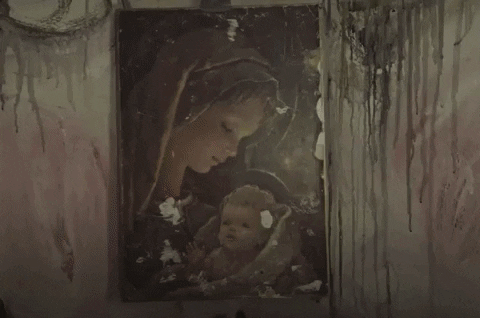| MH Rowe |

La casa lobo (The Wolf House) plays at the Tryon Cinema from Friday, May 31st, through Sunday, June 2nd. Visit trylon.org para boletos y más información.
La casa lobo (2018, released in English as The Wolf House) is one of those films based on or inspired by fact that sends you scurrying to the internet to read aghast secret histories you never knew. In this case the history turns out to be a sickening account of reactionary Germanic-Chilean political violence. Almost defiant in the face of this history, which it still depends upon, the film comprises a stop-motion fantasia that squirms and erupts with images by turns enchanting and alarming. Its fairy-tale narrative unsettles you, too. A blond girl named Maria—she is sometimes a painting or drawing, sometimes a crumbling and self-assembling papier-mâché doll—has escaped a threatening “colony” (she was going to be punished for letting some pigs escape) and is now lost in the woods, pursued by a wolf who, in an unusual twist of fate, also provides some of the film’s voiceover narration. The film’s first narrator introduces the fantasy we see as though it were produced by the same Chilean colony of German immigrants that Maria has fled. There’s more than a whiff of propaganda.
Maria takes refuge in an ever-shifting, self-transforming house she finds among the trees. Which is to say: So far, so creepy, and it only gets worse. Once inside the house, where she can “play and sing,” Maria transforms two “little piggies” into human companions, Ana and Pedro, only to turn Ana and Pedro into blond Aryan children using magic honey that “heals” their “darkened skin.” A fleeting swastika had earlier appeared on a wall, before turning into a window. We’ve been fitted with Nazi glasses, or so it seems. Maria, Ana, and Pedro, now blond and graceful, sing a beautiful hymn while candles burn down and regrow in the foreground.

By the end of the film, the wolf “was always inside you,” as the wolfish narrator puts it, referring to Maria. This is a reversal of the devouring predator in Little Red Riding Hood, yet it still empowers the wolf—or at least the vulpine fascist within. It’s worth noting here that Hitler adopted the nickname “Wolf” among friends. He identified with the legendary predator and even named one of his headquarters during the war “The Wolf’s Lair.” For her part, Maria doesn’t seem to know any better than to reenact the racial fantasy she has presumably been taught, uplifting her Chilean “piggy” friends by turning them blond and white like her. Somewhere along the line, her parents or other racial ideologues have made a weapon of Maria’s sense of innocent play.
All this you can get from simply watching the film, without recourse to Wikipedia or various articles and documentaries. And yet, I’m compelled to object. Not to the film itself. I object to how tempting the historical context of La casa lobo appears to be. For the film is not only some imaginative footnote to this history.
Two things, then. First, Colonia Dignidad. As you will no doubt know if you read anything at all about La casa lobo, the film takes its inspiration from “Dignity Colony,” which was a rural enclave of German immigrants to Chile founded after World War II. Though its members were from the beginning a cult of millenarian and restorationist Christians, they also forged ties to the dictatorship of Augusto Pinochet, with whom they shared strong anti-Communist fears. They cached weapons but soon provided interrogation space for Pinochet’s agents after the 1973 coup that overthrew Salvador Allende’s democratically elected socialist government. Members of the colony later imprisoned, tortured, and killed dissidents themselves. The cult’s leader, Paul Schäfer, was himself a serial child abuser. A former medic in the German army, he had fled accusations of sexual abuse in Germany before arriving in Chile and establishing his pedophilic fiefdom.
The second thing, to put it bluntly and to restrict the scope of this comment to this particular film for what I hope are obvious reasons, who cares about Colonia Dignidad? Of course one cares about such awful history. And as with certain paintings in museums of contemporary art, La casa lobo seems to cry out for a placard to explain all these real-life antecedents and inspirations. I would suggest, however, that this call of the wild be resisted. Part of the reason I don’t care to scurry after these facts and this history in evaluating the film is that at some level La casa lobo doesn’t care about the history either. Never does this film present itself as a documentary. It instead keeps a straight face and pretends, with a touch of Borgesian fabulism, that a made-up and imagined world—both textual and visual—is real. We’re getting the fake real thing, a “real” children’s film made by right-wing fanatics. A fable that is propaganda.

But is it a right-wing film? Is it propaganda? To the extent La casa lobo horrifies us, the answer seems to be yes, as propaganda of this sort should horrify us. Yet the answer is, of course, no. La casa lobo does much more than horrify—though I wouldn’t call it necessarily a left-wing film either.
The imagination represented in Maria’s story is not neat or clear. It exceeds the boundaries we might imagine for a piece of propaganda produced by millenarian Christian fanatics carrying water for a right-wing dictatorship. It calls to mind, yes, fairy tales like Little Red Riding Hood and Snow White but also demented stories like Alice in Wonderland, Jorge Luis Borges’s fables, as well as Mark Danielewski’s novel House of Leaves, the giant leaky dolls and expanding giant baby of Katsuhiro Otomo’s Akira, and finally Nazi mythology and the stories of Roberto Bolaño, who fictionalizes Colonia Dignidad in a chapter from Nazi Literature in the Americas. It may be perverted at some fundamental level, but there’s a soulful strangeness in La casa lobo we can’t reduce to propaganda.
Even if its racial fable unsettles the viewer, the many frightening textures of La casa lobo also free the film from propaganda’s will to power. This is not a program for politics, despite the clear racist fantasy. Its perverted soulfulness can barely contain an endless transformation evident in every frame of the film. And as a film, its images celebrate craft and creation. If this is a piece of propaganda, then the medium is as much the message as the message. As the wolf-narrator says at one point, attempting to repair a lost connection with her: “Maria doesn’t listen to me anymore, but I know you do.” Despite this call for clarity, the lesson to be learned gets fuzzy when it’s conveyed by beautiful paper sculptures that fold and unfold, seemingly of their own will, like self-deconstructing origami. Evil teachers wrestle with the imagination of their charges, after all; they must educate and twist them into ideological compliance, narrow the world to sharpen a vision. In the story of La casa lobo, its only severe hunger that lets the wolf in and brings Maria back into the fold.

La casa lobo’s images are too curious, too inviting, too repellent—all at once—to make sense as clear statements against, for example, indigenous rights to self-determination, or even as statements of racial purity. They draw too much attention to themselves as aesthetic artifacts. Images like these pay homage to the imaginative labor that crafted them. So if the stop-motion film-within-a-film that constitutes La casa lobo is the same thing as Maria’s mind, she proves her childish fantasies to be both rulebound and unruly. She’s in a Nazified wolf’s lair, yet the authoring hand of the wolf seems to gain, lose, and only by a stroke of fate regain control of her. She’s a child. She’s been twisted. Malformed even. “Little pig, do you want me to take care of you?” the wolf threatens.
Art, we should understand, is not essentially affiliated with either justice or injustice and can be made to serve either, or both—or neither. The wolf’s house is in part a metaphor for the refuge where one practices one’s art, a workshop that despite its apparent safety, exposes every Maria who hides there to all of the pious and insidious voices in her head. When she hides in the wolf’s house, she’s still lost in the woods; that’s where the house is.
Edited by Olga Tchepikova-Treon
